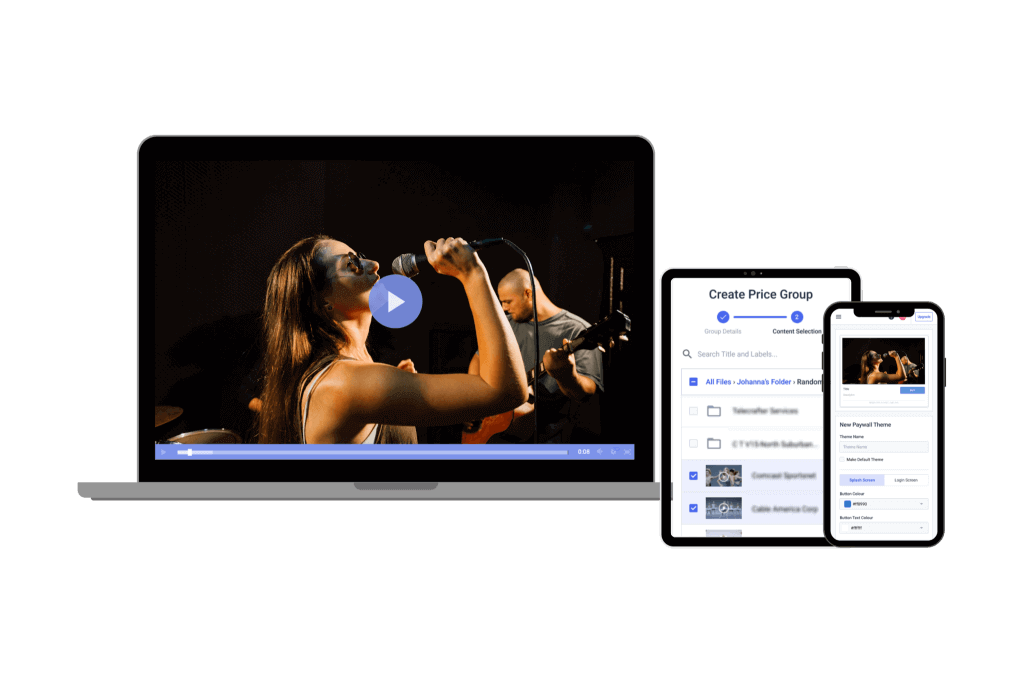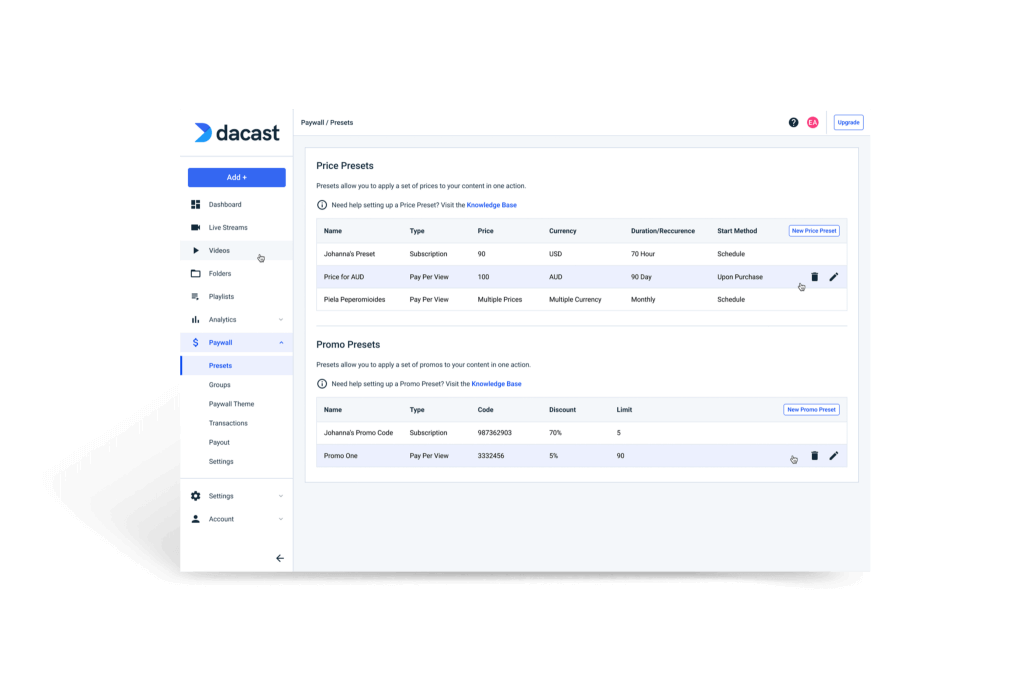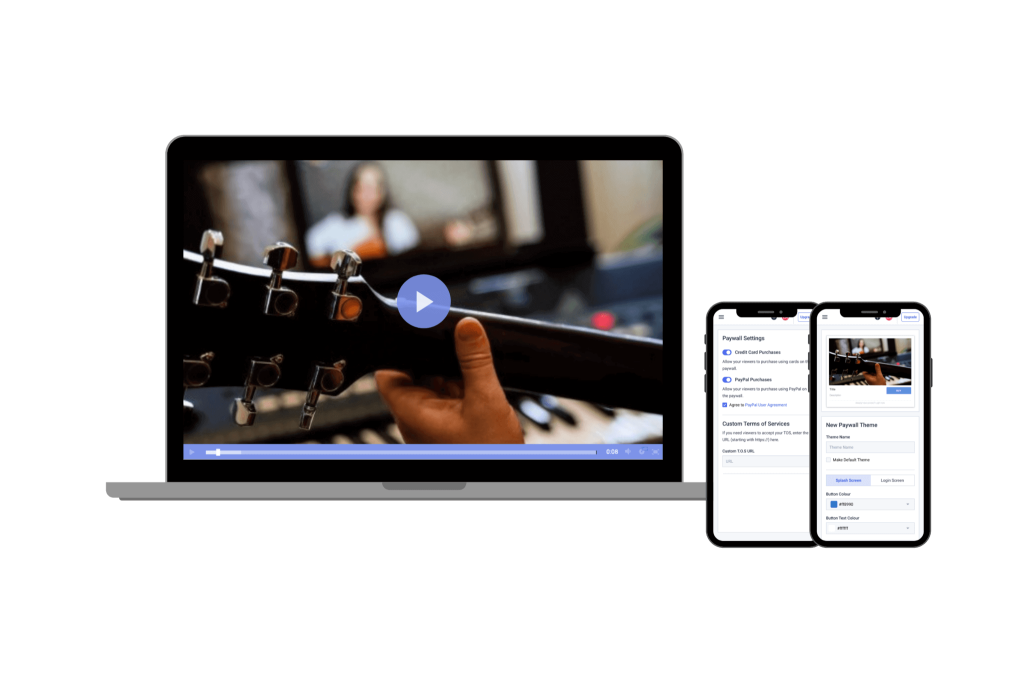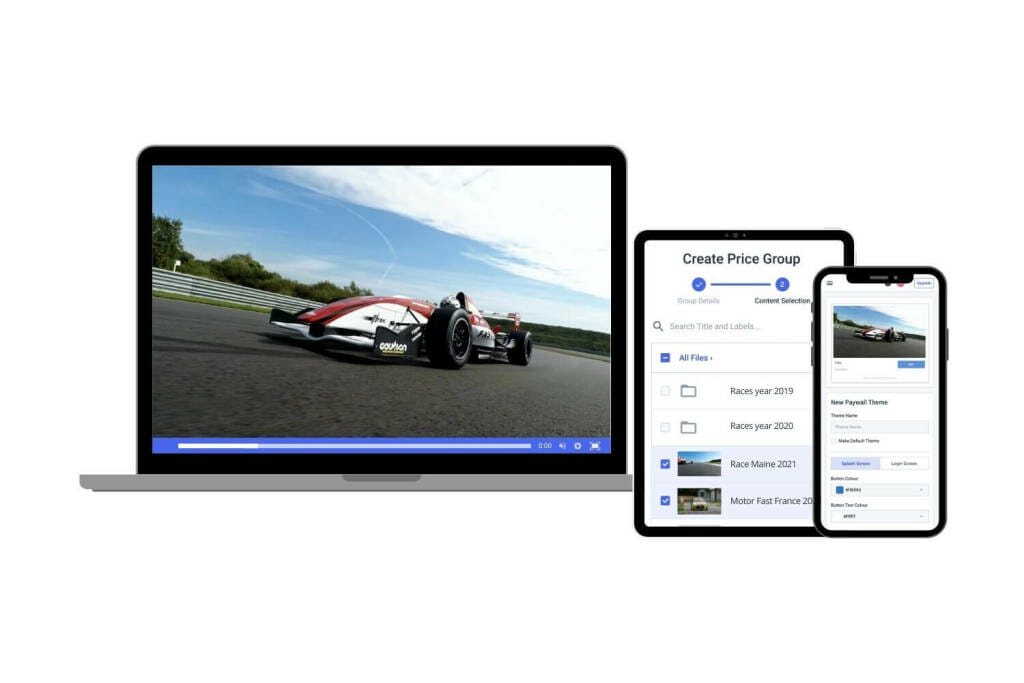How to Choose a Video Paywall Solution for Live Streaming Monetization in 2023
People will gladly pay for quality video content online. Today, people are accustomed to paying through a subscription model, pay-per-view access, a form or forcefully watching commercials. It’s so much part of normal culture today that over-the-top (OTT) revenue streams, which bypasses traditional television for watching video content directly through the internet, will reach a massive $210 billion by 2026.
- What is a Video Paywall?
- Why Use a Paywall to Monetize Your Video Content?
- How a Video Paywall Can Help You Grow Your Business
- How to Choose a Paywall Platform for Video Monetization
- 2. Using an Online Video Platform for Paywall Video Hosting
- Final Thoughts
People will gladly pay for quality video content online. Today, people are accustomed to paying through a subscription model, pay-per-view access, a form or forcefully watching commercials. It’s so much part of normal culture today that over-the-top (OTT) revenue streams, which bypasses traditional television for watching video content directly through the internet, will reach a massive $210 billion by 2026.
While businesses and broadcasters will often monetize video content through advertisements, this isn’t the most effective method. Over time, viewers grow frustrated and may stop viewing their content if it gets too much. On top of that, many viewers will put up ad blockers, which can block up to 40% of total ads, to avoid these ads that generate income. Alternatively, savvy businesses who offer their viewers the option to a paid subscription to watch their content ad-free will often yield larger rewards over time.
In this article, we’ll cover everything you need to know about choosing a professional-grade paywall model. We’ll detail its uses and benefits for professional video hosting and the basics of video monetization. Furthermore, we’ll specify different paywall cases. Finally, we’ll weigh the different options you have for video monetization of your site’s content and help you decide upon the best paywall solution for your needs.
Need a professional video paywall and monetization platform? Try Dacast with a 14-day free trial today.
Get started for free
Table of Contents


Video monetization is the act of getting paid for the videos that you create online. The reach extends well beyond what YouTube offers content creators.
Video monetization is how you make money through the video content you share online. The term refers to putting an active strategy to earn money from your content when users watch it.
The three most popular monetizing video content are advertising, subscriptions, and pay-per-view transactions. Each video monetization business strategy has strengths, weaknesses, and use cases that make sense.
Many businesses and content creators use a combination of monetization strategies to earn money on their video content.
1. SVOD
SVOD stands for “subscription video on demand.” With this monetization method, viewers are charged a subscription fee to access your content.
That subscription fee often provides the viewer access to your entire library of on-demand content for a set period. Or you can use a subscription fee to charge for .
You get to choose how long the subscription lasts. Many popular video platforms with subscription fees, such as Netflix, charge for monthly access.
However, you can charge a subscription for your content’s weekly, monthly, quarterly, or annual access. It is a good idea to look at what type of subscription fees and lengths your competitors charge, so you position your business well.
2. AVOD
AVOD stands for advertising-based monetization for video-on-demand, although you can apply this strategy to live content. YouTube is the most popular example of a video streaming platform that uses AVOD.
It’s a form of advertising that many viewers are familiar with. As a broadcaster, you can work with an advertising network and have them manage the ads that run on your content. Or, you can build relationships directly with sponsors, gathering advertisements to run on your content.
Both ways of forming advertising relationships work; it just depends on how much effort and control you want over the advertisements that run on your content.
One thing to consider with ad-based monetization is that many viewers use ad-blockers to avoid seeing advertisements pop up all over the pages they visit. However, if you use server-side ad insertion, your advertisements are delivered directly through your video player, which usually keeps them from being blocked by most ad blockers.
3. TVOD
TVOD stands for pay-per-view streaming video monetization. Some people also call this transactional video on demand. It’s a model that allows users to purchase content on a pay-per-view.
That means the viewer can pay to access a specific video for a set period. Sometimes, with pay-per-view, a viewer can purchase access to the video content forever. They are paying for access to a specific piece of content.
Many people are familiar with pay-per-view from cable t.v. where you can rent movies or pay for access to special one-time events like boxing matches. The method also works well with online content.
For example, you can sell access to a live concert for a set period. Or you can offer access to all the live content from a web conference for a week.
There are many use cases for pay-per-view access. Just be sure you are clear with the viewer about what they are paying for access and how long that access will last.
That’s why this monetization method has become increasingly popular.
What is a Video Paywall?


Video paywalls keep your content hidden until viewers pay for access.
Have you followed a link to an article or video you wanted to watch only to hit a webpage asking you to pay for access to the content? Then you know what a paywall is. It’s a “wall” between you and the content you want to view; paying is the only way through it.
Paywalls are used for video monetization strategies of online media, but they are not exclusive to video content. You’ll see paywalls online, from newspapers like the New York Times to secure video streaming services.
There are three main types of paywalls:
- Soft Paywall: This is also known as a “metered paywall.” It gives users access to a certain amount of content for free. However, it requires them to pay for complete video content access.
- Hard Paywall: A hard paywall keeps all of your content gated from consumers. Content consumers must pay a recurring or a one-time fee to access your videos.
- Freemium: Similar to a soft paywall but gives the consumers access to a portion of videos for an unlimited time. They’ll need to pay a one-time fee if they want to access the rest of the content.
A video paywall is necessary for SVOD and TVOD monetization. It restricts free access to digital content by requiring a viewer to purchase the video or pay for a subscription to gain access to the content.
A video paywall for monetization gives your business complete control of your prices. You can keep your paywall low and accessible or charge a high-ticket fee for your content. It’s entirely up to you.
Subscriptions to powerful platforms like Hulu, Disney+, and Netflix are between $6 and $20/month, including different access tiers. Hulu, in particular, has several add-ons where users can unlock more and more content for an increased subscription cost.
The future of revenue-generating video is likely a model in which paywall platforms for video monetization become even more prominent. Viewers don’t like the advertising experience and have demonstrated they are willing to pay directly for the video content they want to watch online.
Here at Dacast, we’ve seen our customers experience significant growth in gross incomes when they started using our multiple currency paywall. Dacast makes it easy to customize your paywall and integrate payment solutions, making the process easy for you and your audience.
Why Use a Paywall to Monetize Your Video Content?
Why do you need a paywall? Is it the most effective way to monetize your video content? The answer to both of these questions is a resounding “Yes!”
A paywall allows you to control who has access to your content and provides a way to generate revenue from your video content. Several reasons why using a paywall is the best option for monetizing your video content.
- A paywall ensures that only people willing to pay for your content can access it. That means you can be sure that the people watching your videos are interested in your offer.
- It allows you to set different price points for different types of content. For example, you could charge a higher price for exclusive access to new videos or give discounts for bulk purchases.
- Also, it provides a way to track who is watching your content. This information can be valuable in understanding your audience and tailoring your content to them.
- Paywalls give you the ability to offer a variety of content types, including behind-the-scenes footage, live streams, and more. That helps to keep people engaged with your brand and increases the likelihood that they’ll continue to watch your videos.
- Finally, using a paywall allows you to avoid ads. Ads can be intrusive and distracting and can lower the quality of your video content.
In 2020, digital sales and rentals peaked as the market for people seeking in-home entertainment exploded. In the US, digital entertainment was a $30 billion industry in 2020. Digital sales and rentals increased by 30% between 2014 and 2018. TVOD revenue in the United States is projected to reach $13.5 billion by 2026.
With the paywall model, users can’t access your content until they have paid. That makes video paywalls for video hosting perfect for:
- Hybrid Events – A hybrid event is when people can choose to participate in an event either virtually or in person. The paywall asks for the ticket-taker and allows access.
- Music Shows – Virtual concerts might never completely replace in-person concerts, but they can give musicians more opportunities to perform and increase access. An in-person concert limits the number of people that can fit in the building and watch it. A video paywall makes it possible to sell tickets to unlimited viewers.
- Sports – Sports are a little different than concerts in that viewers are more accustomed to paying for virtual access to events. Instead of buying a hefty cable package and enduring the commercials, a paywall is an upgrade.
- Business Conferences – Traveling for a weekend business conference isn’t always feasible or desirable. A virtual business conference makes getting more participants and potentially more speakers easier and more cost-effective. A conference is a great candidate for a hybrid event as well. If you’re already going to hold the event in person, why not offer tickets to an exponentially more significant number of viewers using a paywall?
- One-Time Events – Holding a one-time event in person means you have one chance to sell access to one room full of people. Setting up a paywall and offering the content virtually allows you to sell unlimited tickets over a more extended period.
If creating and broadcasting content is an integral part of your business, hosting videos behind a paywall is the best way to control how and where your content is being viewed.
Using a video streaming platform with a paywall integration helps protect your business from the whims of another company’s algorithms. In addition, it protects you when legislation or advertisers become an obstacle on a free video platform like YouTube.
How a Video Paywall Can Help You Grow Your Business
Video content is highly effective as a marketing tool. We’ve known that for the last two decades. But a paywall can help you turn your marketing tool into a source of revenue.
There’s a good reason why nearly 50% of media outlets in the United States use paywalls to generate revenue in one way or another. And that’s because it works!
A video paywall can help you in several ways, including:
- Increasing brand awareness: A video paywall helps to increase brand awareness by giving people a reason to visit your website or blog. When they see your videos, they’ll be more likely to remember your brand and come back for more.
- Generating revenue: Making money is the ultimate goal for any business, and a video paywall can help you do that. By charging for access to your videos, you can generate revenue that can be used to grow your business.
- Increasing engagement: A paywall also helps to increase engagement by giving people a reason to watch your videos. When they know they’ll be able to access your content, they’re more likely to watch it.
- Building an audience: You’re trying to build up a loyal audience on a video streaming platform like YouTube? A video paywall can help with that too. You can build up a loyal and engaged audience by making your videos accessible only to people willing to pay.
- Creating loyalty: Creating a paywall also helps to create loyalty among your viewers. When they know they can access your content only by paying, they’re more likely to be loyal to your brand.
Using a paywall can avoid the expense and time commitment of creating ads. And you can also avoid having to partner with another brand or website to display your ads.
How to Choose a Paywall Platform for Video Monetization
The video monetization market is growing at a CAGR of 8% and is worth billions. Naturally, there’s a lot of competition out there. Selecting the right video paywall service is essential to ensuring that you can generate revenue from your content.
Before we move on to the features you need to pay attention to, let’s see some of the challenges you may face while selecting a video paywall platform:
- The high cost of entry: Some video paywall services can be costly, especially if you’re starting. Make sure to compare the prices of different platforms before making a decision.
- Lack of flexibility: Not all video paywall solutions are created equal. Some may be very inflexible, making it difficult to customize your content or offer different content types.
- Limited payment options: Some video paywall platforms only allow you to accept payments through a few select methods. That can limit your ability to generate revenue from your content.
- Lack of customer support: If you run into trouble with your video paywall platform, you’ll want to be able to get help from customer support. Not all platforms offer this, so check before you sign up.
There are a variety of solutions on the market. Still, these solutions are not all created equal. Some have only basic features, and some only support advertising monetization.
As a broadcaster looking into a video paywall platform, we suggest looking for the following features:
- White-label paywall + invoicing: Ensure that no other business’s branding is on the paywall or customer receipts. A white-label streaming service will only display your business name and logo to customers.
- Security: Ensure your paywall platform is secure so that all sensitive information is kept private.
- Easy to use: Minimize clicks and clutter to maximize conversion rates.
- Multiple currency support: Your streams are accessible globally. Multi-currency support automatically speaks to users directly, maximizing sales.
- Multiple language support: Your streams become accessible to people who speak a different language than you. That allows for audience growth.
- Different monetization options: Support subscriptions and pay-per-view streaming on the same content library with flexible configuration.
- Promo codes: Offer sales and discounts.
- Schedule pricing: Offer a discount for early purchases, start charging more after a specific date or schedule a time when sales begin. That feature boosts excitement and fear of missing out (FOMO) to drive early purchases.
- Video preview: Give customers a taste of what they’re purchasing by showing them a teaser for sale video content.
- Terms of service: Monetize on your terms by including custom terms of service agreement for purchasers. That allows you to protect yourself against legal threats and cover all legal requirements.
Now that we’ve reviewed essential features, it’s time to discuss how you can access a live stream paywall for your business.
There are two main methods, the first is an external video monetization platform, and the second is by using an online video platform that offers a built-in paywall.
Each has its advantages, so let’s examine them both.
1. Using Your Own Monetization Platform


When picking a video monetization platform, make sure it offers the ability to scale your business in the future.
One way to access a high-end paywall platform is to contract with a third-party paywall provider such as:
- Cleeng – Cleeng supports pre-registration for live events and Digital Rights Management (DRM) for privacy. Cleeng keeps selling PDF files or other downloads alongside your video content.
- – Security is a significant focus of InPlayer, which is PCI Security Council certified. InPlayer also supports a Facebook paywall option and plugins for popular streaming CMS platforms.
- Piano – Piano’s paywall service is a sophisticated platform that supports billing, communications, and sales tax across multiple jurisdictions.
Each of these services offers sophisticated and powerful video paywalls with unique features.
Unfortunately, there are a few potential drawbacks to using your own monetization platform, including:
- Integration between both platforms is ideal, so the ability to integrate external applications with your online video platform is essential.
- It may not be compatible with your online video platform. At Dacast, we are compatible with Cleeng and InPlayer (our paywall is on InPlayer).
Using a third-party video paywall requires a second subscription (in addition to your OVP).
2. Using an Online Video Platform for Paywall Video Hosting


Dacast’s OVP now allows organizations of all types to quickly and easily use paywalls for live streams and video-on-demand content.
The other option is to use the video paywall built into your chosen online platform. Not every live-streaming platform has a built-in paywall, so this is something that you will want to keep in mind as you weigh your options.
Dacast, for example, has directly integrated the InPlayer paywall into our solutions. Dacast users have access to a powerful video paywall for no additional charge.
Thе fully integrated system supports the pay-per-view video monetization model and recurring subscriptions.
One of the best features of Dacast’s InPlayer paywall is multi-currency support. Our internal metrics show that multi-currency support is one of the most popular features for users of the Dacast paywall The feature allows you to engage your global audience and maximize revenue.
In addition to the features we mentioned above, some other things to look for when finding an online video player with a suitable built-in video paywall include:
- Credit card and PayPal support: Multiple payment options to make transactions easy for many customers.
- Sales dashboard and audience CRM: Track revenue and content performance and gather customer contact information.
- Analytics: Aggregate and analyze viewer location, device usage, country and city, length of viewing time, etc.
- Group pricing: Charge a single fee to access a content bundle.
Final Thoughts
To maximize your business revenue, monetizing your video content is crucial. Thankfully today there are many options to choose from. This includes AVOD, TVOD and SVOD, or a combination that works best for your company.
Dacast is a professional video streaming platform that enables businesses to quickly and easily deliver and monetize online video content. Our video paywall gives you 100% control over your video content. Through our partnership with InPlayer, we can offer your business the right solution specific to your needs. Dacast also provides a range of top-tier features such as CDN delivery, comprehensive analytics and custom professional services to get you up and running. You’ll be able to set up a metered paywall and onboard paid subscribers in no time.
Ready to start monetizing your online video content? Try our video paywall platform hosting for free with our 14-day risk-free trial.
Try now for free
You can also join our for exclusive offers and regular tips on live streaming. If you have a success story about using paywalls to monetize your content, we’d love to hear from you in the comments below. Or, if you have any other questions about the paywall live stream, please contact us. We’ll get back to you!
Good luck with your sales, and thanks for reading.

 Connect
Connect
 Events
Events Business
Business Organizations
Organizations Entertainment and Media
Entertainment and Media API
API Tools
Tools Learning Center
Learning Center Support
Support Support Articles
Support Articles